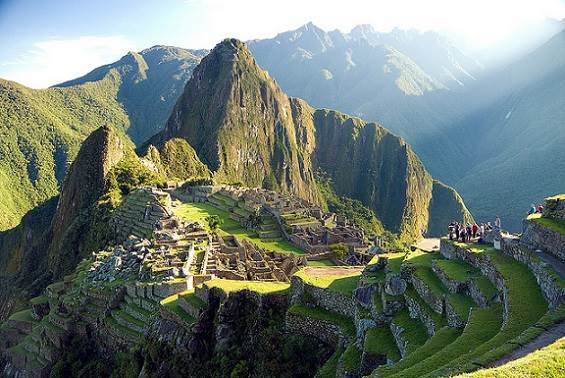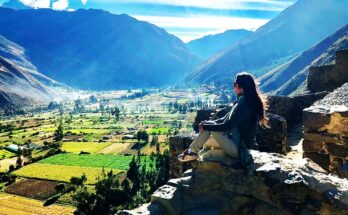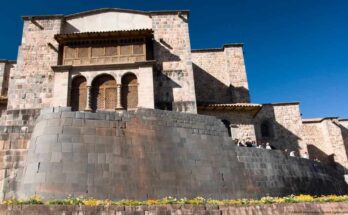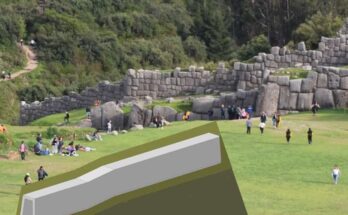There are many incredible places in Peru to visit which is why I have created this list of 7 popular and lesser known tourist destinations in Peru.
Huacachina
The incredible Huacachina is located near Ica. It is a small oasis town that encircles a natural lake and is surrounded by magnificent sand dunes. It was once a retreat for the rich, but nowadays Huacachina mainly draws in international tourists from all walks of life.
Mancora
Mancora is located on the northern coast. It is a small town that features the most beautiful beaches which stretches for many kilometers along the Pacific. The town also has a big variety of luxury beach resorts, great restaurants and nightclubs. Mancora is also a well known surfing destination that attracts surfers from around the world.
Colca Canyon
The breathtaking Colca Canyon is a large canyon that belongs to the Colca River. It can be found in the southern regions of Peru. The biggest attraction here, in addition to the amazing sights, are the Andean condors. The condors are only visible from close range because they float on the thermals.
The Nazca Lines
The mysterious Nazca Lines can be found along the northern Pacific coast of Peru. It was created about 2000 years ago and the figures vary from basic lines to detailed wildlife and human shapes. The lines were created on a very large scale and many hotels and tour agents in Nazca offer scenic flights in a Cessna to view the lines. There is also an observation tower down the Pan-American highway with a view of some of the figures.
The Santa Catalina Monastery
The beautiful Santa Catalina Monastery, which can be found in Arequipa was established in 1580 and covers a walled area of about 20,000 square meters and is complete with walls, streets, walkways, stairways and little squares. The monastery is mainly of the Mudéjar style, and it is characterized by the beautifully painted walls. It is one of the most remarkable monasteries of Latin America.
The Uros Islands
The incredible Uros Islands are made of dried out totora reeds and these synthetic islands are Lake Titicaca’s leading tourist attraction. It is truly one of the most unique places in Peru and the lifestyles of the Uros are interwoven with these types of reeds, which is their main source of food and is also be utilized to help build their houses.
The Ancient Ruins of Machu Picchu
Machu Picchu is one of the most stunning and extraordinary ancient sites on the planet, it is also the most popular tourist attraction in Peru. The ruins are unseen from the Urubamba Valley below and totally self contained, encompassed by various farming terraces as well as watered by beautiful natural springs. Machu Picchu was known locally, but was mostly unknown to the outside world prior to being discovered in 1911.

Lambeyeque – Chiclayo
The Lambayeque capitol city of Chiclayo is nestled between the Zana and Lambayeque valleys, two fertile areas known for their cotton, sugar cane and rice plantations. While not actually on the beach, Chiclayo is, at its heart, a coastal town. Like much of the northern coast, it has a warm and sunny climate year round. The winter months (December through March) are considered the rainy season, with very light rain that can be heavier during El Nino years. Chiclayo is a meeting point for the towns of the northern coast, mountain and jungle regions and as such is the largest commercial area north of Lima. It’s a festive town where the motto is “Work can wait, but not a party!” With nearby beaches, friendly people and interesting attractions, Chiclayo is becoming a favorite destination for tourists.
The beach resort and port of Pimentel is considered to be the fashionable beach for Chiclayanos to visit in the summer. About 20 minutes west of Chiclayo, the former small fishing port now features a pleasant beach resort. You’ll find a pleasant mixture of traditional and modern worlds as you watch surfers compete for waves with reed fishing boats. The beach features a number of hostels and restaurants.
About 40 minutes southeast of Chiclayo, you’ll find the famous archeological site of Sipan, where the Peruvian archeologist Walter Alva discovered one of the richest pre-Hispanic burial sites of the Americas, El Senor de Sipan (The Lord of Sipan). The original find was that of a young dignitary of the Moche people. Later, two more tombs were discovered, that of an older dignitary and of a priest. The entire find is considered very important, because the tombs were intact and had been untouched by thieves – a serious problem at many archeological areas in the country. Tours of the site can be arranged by several agencies in Chiclayo.
Like many cities in Peru, Chiclayo has a distinctive local cuisine that absolutely must be sampled. Chifles con cecina are a favorite entrée, made of fried plantain chips and bacon. Another plantain dish is mala rabia, a puree that’s flavored with cheese and Peruvian aji pepper. Some favorite main dishes are arroz con pato, or rice with duck, done in the Chiclayano style with beer, hierbabuena and lots of cilantro. Cabrito a la chiclayana is a stew made from young goat that has marinated in chicha (a fermented corn brew) for a unique flavor. These dishes and many more can be enjoyed at huariques, restaurants that specialize in local dishes. You can find many of them on the avenues La Union, Grau and Bolognesi. Ask a local to recommend their favorite!
Chiclayo has several festivals worth noting, with the year’s highlight being in September with the procession of the Nuestro Senor Cautivo de Monsefu (Our Captive Lord of Monsefu). According to legend, this effigy of Christ was found washed up on the beach nearby. It is said that the effigy will escape to perform miracles in other towns if not kept bound in chains!
If you’re staying in Chiclayo, you’ll find that hotel rates and restaurant prices are very reasonable. The Gran Hotel Chiclayo is recommended, with a double room costing about $100 per night and junior suites available for $112. For the more budget minded, try the Hotel Aristi, where a double room runs about $30.
Chimbote
It’s no secret that the ancient Incan city of Machu Picchu is Peru’s top tourist draw, attracting thousands of visitors each year. But many people don’t know that Peru is a country full of amazing things to see, from the coast to the mountains to the jungles. Chimbote, located about 430 km north of Lima, is mainly a fishing port, and not generally considered among top tourist sites. The town was rebuilt after nearly being destroyed in Peru’s 1970 earthquake, and apart from a lovely Plaza de Armas, there isn’t much to see or do in the city proper. However, its close proximity to several important archaeological sites, pleasant beaches and great regional foods make it a great spot for off the beaten path travel.
Various nearby archaeological sites in the area give fascinating proof of the history of long ago inhabitants of the area now occupied by present day Chimbote. One of those sites is Sechín, considered one of the most important pre-Hispanic ceremonial sites on Peru’s coast. Sechín Bajo consists of five buildings, an underground gallery and a semi-flooded plaza. Built over 5000 years ago, it’s one of the oldest structures found in Peru. A little further south, you’ll find another intriguing archaeological site, known as Chanquillo (or Chankillo). Chanquillo isn’t your typical ceremonial site or fortress – it has been confirmed that it was actually used as a solar observatory, and is believed to be the oldest of its type in South America.
If the ancient world isn’t your thing, you may find a lot to like in Chimbote’s beaches, which are popular among both sunbathers and surfers. The beaches that surround Chimbote are most busy in the summer season, from January to February. About 40 km to the south of Chimbote, you’ll find Tortugas, one of the best known beaches in the area. It’s a great place to enjoy the Pacific breeze, and the restaurants in the area are known for their delightful ceviche specialties. A little further south, at El Huaro and La Gramita you’ll find sandy beaches that are favorites among campers. Swimming, diving and boating are other beach activities you can enjoy here.
Peru is well known for its unequaled cuisine, and the Chimbote area certainly lives up to the reputation. Its coastal location of course provides for delectable seafood dishes and ceviche is a natural choice. But one dish you absolutely can’t miss is ceviche de pato casimeño, made from tender portions of duck marinated in a delicious orange/lemon sauce. It’s one of the most popular dishes served in the restaurants around Casma, south of Chimbote.
So if you’re looking for a Peruvian adventure that’s far from the regular tourist rounds, you may find that the Chimbote region has what you’re looking for. It’s an easy stopping off point for travelers between Lima and Trujillo, and bus fare from either city is quite reasonably priced. Nearby archaeological sites provide a bit of history, and lovely beaches are available for camping, swimming or surfing. After a busy day of fun, you can fill yourself up on delicious meals that won’t soon be forgotten. Chimbote is a perfect location for those that prefer traveling off the beaten path.
Huaraz
This city is not on the beaten paths of Cuzco and Lima, but offers spectacular, natural views at a fraction of the price of the more popular destinations. It’s a backpacker’s dream come true.
Not accessible by commercial air, tour buses such as Cruz del Sur buses are available from Lima (8 hours). Prices range from $23-$30 one-way, but I recommend the first-class seats, located on the lower deck, due to the winding mountain roads of the Andes. The overnight bus arrives in the early morning hours, perfect for starting the day with a tour of the attractions of Huaraz, such as a day trip to the ancient ritual center of the Chavin culture, east of the city. A hike, however tempting, will be more difficult due to the high altitude (The city of Huaraz sits at 10,000 feet).
A number of lodging options are available in town, with some modest rooms as low as $5-$10/person for those backpackers on a tight budget. My family and I decided to stay at The Lazy Dog Inn, which sits quietly up on the beautiful mountainside, offering clean, private cabins with hot water, family dining for all meals, and a wood-stove sauna. The owners are from Canada, and speak both English and Spanish fluently. The business is very tranquil and earth-conscious, serving fresh organic vegetables grown on-site. There are even actual lazy dogs there, and the rooms and cabins are offered at around $100/night, but include breakfast and dinner, with additional meals/services available. Expect to pay around $12 for a taxi to take you there.
The advantage of the Lazy Dog is clear if you came to Huaraz for hiking and spectacular scenery. The inn rests near a large field of boulders, near a trail head leading to the Laguna Llacas, where a high mountain mineral lake is fed by an active glacier, nestled at the top of a lush box canyon, where an icy stream rushes through green fields. A taxi can be taken to the dam for about $35, and the hike back downhill to the inn takes about four hours. Diana, the inn’s owner, draws a decent map, but be sure to take your rain gear during the wet season.
Huaraz might not be the typical tourist destination, but for those seeking a tranquil connection to the planet, this is the place to be.
The Sican National Museum in Chiclayo
To confuse visitors who may already be addled by higher altitudes, not only is there a museum of the Royal Tombs of Sipan (Museo Tumbas Reales de Sipan), but the Leymebamba Museum. The Sican Museum and Sipan ones both show a lot of gilded objects from elite burials. (The lords of Sipan were Moche rather than Sican; as already noted, Moche civilization preceded Sican.)
The permanent exhibition materials in the museum are from the ancient city Poma, located at Batán Grande, now a nature reserve and historically a place of extensive tomb-raiding (more than a hundred thousand pits!).
The city was founded around 750-800 AD and burned around 1100 AD. A new Sican capital was then built ten kilometers northwest at Técume. (There is also a small museum at edge of the Pyramids of Técume, along with ruins of 250 brick pyramids.)
Poma flourished by the beginning of the tenth century with developed metallurgy and molded (palateado) ceramics, including a lot of zoomorphic ones. In addition to gold-plating, the Sican artisans learned how to smelt arsenical copper and aresenical bronze to make utilitarian objects like knives and shovels in addition to the extensive decorative art recovered from tombs.
The museum has a number of dioramas and details about Sican technology. What is most memorable, however, is the reconstruction of a tomb in which the man (presumably a theocrat king) was hung upside down in a crouching position with his head uplifted behind a 14-carat gold mask with emerald eyes, surrounded by objects (1.tons of them, two-thirds arsenical copper) and people (two adult females, two adolescent males) to serve him in the afterlife.
The tomb was also booby-trapped with poisonous gas that would be released by opening it. (This was dissipated by centuries of rain seepage.)
The Museum is a truncated pyramid to showcase, research, and conserve ancient Sican culture. Beginning in 2004, a cultural identity program began to teach children what Sican signifies for people from Ferreñafe and northern Peru more generally.
The ground floor provides room for temporary exhibitions and for a continuously looping video in Spanish that is well worth viewing even with no understanding of Spanish. There was an outstanding one of Peruvian painter ѐañaque while we were there.
The Museum is open from Tuesday to Sunday from 9.00 am to 6.00 PM. Adult admission is 8 soles (under $3 US). There is a small gift shop and a cafe on the ground floor. Outisde, one of the viringo (hairless dogs) roams about and does tricks .



